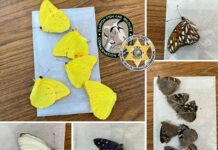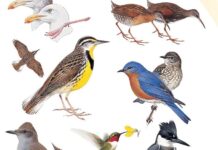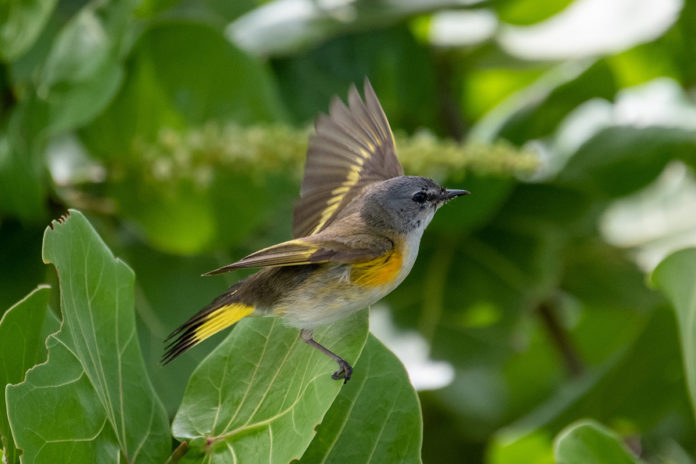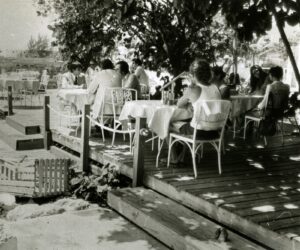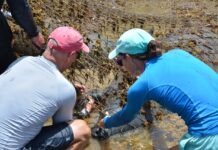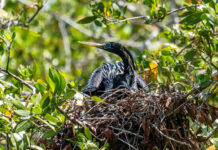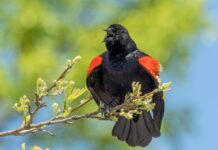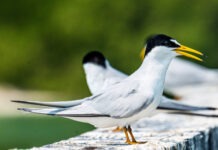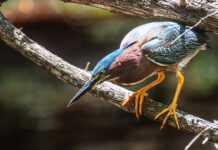Migration was over, at least officially, so a common yellowthroat shouldn’t have been in the seagrape, but there she was, flitting around as if schedules and range maps didn’t apply to her. Female common yellowthroats always look a little caught out to me. Males have this black mask across their face that contrasts with their yellow throat. It’s dramatically graphic and reminiscent of an old-school cartoon burglar, giving them a certain swashbuckling air.
Females have very similar coloring, if slightly duller, but without the bandit mask. Their vibe is more like they’re out trying to run some errands, hoping they don’t run into anyone they know.
I would have sat there and pondered the vagaries of avian sexual dimorphism further except I heard the chipping of another warbler in the mahogany, and then another in one of the bushes in the across-the-street neighbor’s yard, a triangulation that made me think perhaps migration wasn’t as over as it was supposed to be.
It seemed a front had passed through the night before. The humidity was down a bit. There were puddles here and there, including one in the park entrance road that looked to be filled with clouds until a least tern landed in it to bathe and the whole thing shimmered into abstraction.
There didn’t seem to be much going on at first, and for a moment I wondered if three warblers was all the fallout I was going to get. Possibly I was distracted by the butterflies, small clouds of them everywhere looking like snow flurries. They were all Cassius blues, about the size of your pinky nail, always in motion, though when they did alight on a branch and fold their wings, they pretty much disappeared from sight.
But then I started to clue into things. There was another female common yellowthroat at first, then a female black-throated blue warbler. Then a male black-throated blue. Then came the American redstarts, one or two at first, but then groups of eight or 10. Mostly they were female, which makes sense, as males tend to race back to their breeding grounds first to stake out claims to their territories. Females arrive a little later, picking out mates once the turf wars are over.
Over by the blacksmith shop at Fort Taylor a couple Civil War reenactors rolled by in golf carts. In a bush by the bottom of the small hill I thought I saw yet another female common yellowthroat, at least according to the yellow under-rump and the generally olive-y brown plumage, but then I caught the white eye ring and the lack of a yellow throat and realized it was something different. I’d forgotten my phone at the house and couldn’t look it up in the Sibley’s, so I took some notes on a scrap of paper and moved on. (Later I’d figure out it was a Connecticut warbler, a bird I’d only seen five or six times before. It was probably the best bird of the migration for me, even if it wasn’t a great look, but at the time it was just a “huh,” and another one of life’s small mysteries.)
The thing that threw me was the singing. A warbler, somewhere way above, was masked through a couple layers of trees, but the song was clear and high and crisp, like the bubbles in club soda. I tried to find it, but the singing stopped just before I could get a bead on it.
I continued to wander, seeing more and more birds – a male Cape May warbler, a half-dozen blackpoll warblers.
The proper way to think about all this was as a bell curve. In most birders’ minds, migration in the Keys lasts from mid-April until the first week of May. But it’s really a build-up, a peak, and a decrease, starting earlier and continuing longer than we think. What we see on the ground is just a sample — usually brought about by weather — of what’s been going on overhead.
Instead I kept thinking about Raymond Carver, specifically “Gravy,” one of the poems in his last collection.
Carver was a raging alcoholic for most of his life — a fired-from-his-job, evicted-from-his-house, left-his-life-in-ashes kind of alcoholic. Writing honestly about it made him a great writer. Living through it nearly killed him.
In “Gravy” he talks about how a doctor told him he’d be dead in six months if he kept drinking. He got sober, lived clean for a decade, if you didn’t count cigarettes, then was diagnosed with terminal lung cancer. (In another poem, he writes about the urge to stand up and shake the doctor’s hand after he pointed out all the tumors on the x-ray.) The last three lines of the poem are these: “I’m a lucky man. / I’ve had ten years longer than I or anyone / expected. Pure Gravy. And don’t forget it.”
I’ve carried that poem with me for a long time, not because I’ve ever nearly wrecked my life through hardcore substance abuse, but more because I’ve had a couple incidents where I’m not quite sure, decades later, how I walked away alive. And how could everything since not be gravy?
But it also always resonates with me on a smaller scale, like when I experience a small, good thing that wasn’t supposed to happen. For instance, on a Sunday in mid-May, when the migration is supposed to be over but it’s not, and there’s something of a fallout going on, and you find yourself wandering through the woods and hear a bird singing. And you finally manage to find the bird down in a tree right on the edge of the ocean. And it turns out to be a palm warbler, probably the most common wintering bird in the place you live, a bird you have seen thousands and thousands of times before, but have never, until right then, heard sing. Gravy.







